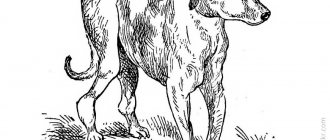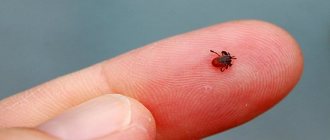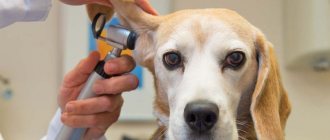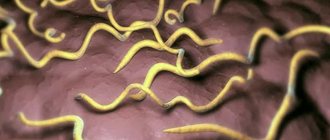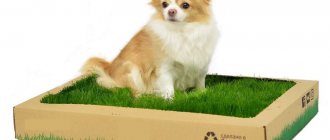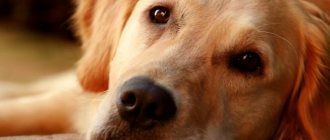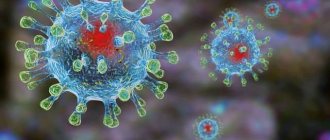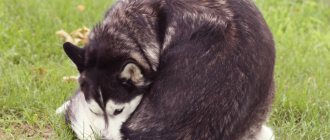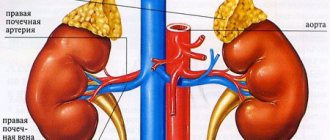Dogs tend to have fasting days. It looks something like this: a visually healthy and active pet categorically refuses food and drinks normally. The diet can last up to 2 days and during this time, the dog will lose some weight. How noticeable the weight loss will be depends on the pet’s physical fitness. Four-legged animals suffering from excess weight lose weight very noticeably, which can only be beneficial.
How to understand that an animal is losing weight
They try to keep working (hunting) dogs in shape.
For some breeds, thinness is a distinctive feature, so it is not always possible to immediately notice the first signs of weight loss.
The following symptoms will indicate that your pet is having problems:
If a dog's ribs are palpable (although they are not visible through the skin), this is the first sign that the animal has begun to lose weight. However, it may still be in relatively normal physical shape.- If you notice protruding pelvic bones, you need to sound the alarm. This is a dangerous sign indicating health problems.
- If the dog has turned from an energetic dog into a lethargic, apathetic one, it means that it needs to be examined, and weight control must be carried out.
- Wool is an ideal indicator of an animal's condition. As weight decreases, the cover becomes dull. The bristles not only begin to fall out, but the pet becomes bald in places.
A dog that is losing weight can be not only lethargic, but also pathologically irritable. With a sharp decrease in weight, the animal develops shortness of breath, chills, and a rise in temperature. Frequent, profuse vomiting is possible.
Normal weight of dogs
At normal weight, the dog's ribs, croup and heads of the hip bones (moslaki) can be felt. Visually, neither the ribs nor the muscles should stick out. There are a number of breeds for which thinness is the norm. Some four-legged animals are naturally lean, for example, among one breed of shepherd dogs you can find tightly built and “dry” dogs.
In furry four-legged animals, sudden weight loss is difficult to notice, but if the weight loss is associated with an illness, accompanying symptoms will also appear:
- Sudden weight loss is accompanied by problems with the coat: hair loss, loss of shine, thinning or dry hair.
- Behavioral changes are also obvious: lethargy, irritability, lack of interest in walks and games.
Important! If the reason for weight loss is illness, weight loss is accompanied by vomiting, diarrhea, fever or drop in temperature, tremors, breathing problems, weakness and drowsiness, sometimes aggression or inappropriately active behavior.
Symptoms and signs of underweight
Body weight is closely related to overall well-being. A normal weight dog is active and playful. Her waist begins just behind her lower ribs and is clearly visible when viewed from above. Also, a healthy animal has a tucked belly and imperceptible, but palpable ribs. They must be covered with a small layer of subcutaneous fat.
With exhaustion or obesity, metabolism is disrupted and there is a high likelihood of developing arthritis. If you notice behavioral changes, carefully examine your pet. Depending on external symptoms, there are 4 deviations from normal weight:
- Obesity
. The dog has massive fat deposits on the chest, lower back and base of the tail. There is no waist. - Overweight
. The transition to the waist is almost lost. Fatty deposits are visible on the lower back and at the base of the tail. The ribs are difficult to palpate, as they are covered with a thick layer of fat. - Underweight
. The transition to the waist is sharply defined. The pelvic bones and lumbar vertebrae are visible. When palpating the ribs, subcutaneous fat is not felt. - Dystrophy
. Loss of muscle mass and lack of fat reserves are obvious. Protruding bones are clearly visible from the side.
In the first two cases, the dog is put on a diet and physical activity is increased. Despite popular belief, gaining pounds is much more difficult than losing it. To gain not only fat, but also muscle mass, you will have to work hard - both the owner and the dog itself.
Causes of hypothyroidism in dogs
Hypothyroidism in dogs can be the result of congenital or acquired pathology.
There is evidence that indicates a genetic predisposition to hypothyroidism. If a bitch does not produce enough thyroid hormones during pregnancy, the fetus may develop serious endocrine disorders.
For example, cretinism. This disease causes various pathologies of the nervous system and delayed physical development. There is a description of the extreme manifestations of cretinism in dogs. These animals are not amenable to socialization, do not respond to affection or aggression from humans and animals, and are not able to find food for themselves.
Congenital hypothyroidism can cause dwarfism. In this case, dogs are very small in stature compared to other animals of the same sex, age and breed.
If thyroid tissue is destroyed during the dog’s life, then we are talking about primary acquired hypothyroidism.
It can be called:
- Chronic inflammation of the thyroid gland, as a result of a genetic defect in the immune system. Immune cells begin to perceive the thyroid tissue as foreign and attack it. As a result, hormone secretion decreases and TSH levels rise, hypothyroidism develops. This condition is called autoimmune thyroiditis or Hashimoto's thyroiditis.
- Changes in the tissues of the thyroid gland of unknown origin or idiopathic atrophy of the thyroid gland.
- Lack of iodine in food and water.
- Tumors of the thyroid gland.
- Infectious diseases.
What is dangerous about primary acquired hypothyroidism in dogs? As a result of a decrease in the synthesis of hormones in the thyroid gland, there is an increase in the production of TSH in the pituitary gland. The difficulty is that TSH synthesis has a periodic or “pulsating” nature, so a number of values may remain normal. This is how the early stage manifests itself, it is also called compensated hypothyroidism. It is registered in 7-18% of animals.
The longer the lack of thyroid hormones, the more TSH is produced. Long-term primary hypothyroidism in dogs can cause depletion of TSH synthesis, which will lead to a serious disruption in the body's metabolic processes. This is late stage or progressive hypothyroidism.
TSH levels can be affected by medications, for example, sulfonamides, glucocorticoids, progesterone and others, giving a false picture of primary hypothyroidism.
If the secretion of thyroid hormones changes as a result of pathologies of other organs, then this condition is called secondary acquired hypothyroidism. First of all, this concerns insufficient synthesis of the hormone TSH in the pituitary gland.
Causes:
- Congenital anomalies, inflammatory processes, tumors or injuries of the pituitary gland. In this case, there is no pathology in the thyroid gland itself, but it is the lack of TSH that causes changes in its cells. In practice, irreversible changes in the pituitary gland are rare.
- The use of anticonvulsants and glucocorticoids, both in the form of drugs and in natural products.
- Unbalanced feeding.
- Removal of the thyroid gland.
- Other pathologies: chronic heart or kidney failure, sepsis, traumatic brain injury, etc. In this case, the main thing is that the violation of hormonal status is secondary, and it is determined not by the origin of the disease, but by its severity.
Another important point. There are a number of factors, for example, pregnancy or diseases of the liver, pancreas, infections, which can distort the real level of thyroid hormones in the blood.
In severe cases of hypothyroidism, dogs develop coma. This is a condition in which serious disorders occur in the brain, cardiovascular system and other organs. The fatal outcome in this case is about 50%.
Causes of pet exhaustion
The dog eats well, but at the same time loses weight, often due to improper nutrition. This can be caused by various factors:
The animal’s food needs have increased, and they are associated with the following points:- the pet is too active and wastes energy on movements;
- pregnant and lactating dogs require increased nutrition;
- The puppy is growing quickly and needs high-calorie food.
- Low-calorie food.
- Unbalanced diet and lack of calories, but the dog has a good appetite and eats a lot.
- A sudden transfer to a different diet: the dog may begin to lose weight due to stress or even refuse unusual food.
- Extreme heat: The dog eats less well, but drinks a lot of water and can still remain active.
Dietary problems can be easily fixed. But if, after adjusting the diet, the owner notices that the dog continues to lose weight, one should look for internal reasons.
Why does a dog lose weight?
| Factors | Description |
| Gastrointestinal diseases | Poor quality nutrition can provoke the development of gastritis, pancreatitis, colitis, and stomach ulcers. |
| Infestations | Even with a balanced diet, sudden weight loss is observed if helminths have settled in the body. Their presence can lead to volvulus. In this case, the dog does not eat anything, and its belly is large |
| Wounds in the mouth | If your pet doesn’t eat well or refuses food and drinks a lot of water, you should look into its mouth; it may have broken teeth, damaged palate or larynx. |
| Ear problems | Infectious diseases affecting the hearing aid make chewing difficult |
| Viruses | The animal may become ill with adenovirus or hepatitis. To exclude these diagnoses, any rapid weight loss in your pet should be examined. |
| Allergy | Both harmful environmental elements and an allergic reaction to new products can lead to the problem. |
| Oncology | Sudden weight loss with refusal to eat may be a sign of the development of cancerous tumors |
Sometimes dogs end up on the operating table, and after anesthesia have difficulty returning to their usual diet.
This situation is considered normal if it lasts 2-3 days. Stable dynamics of weight loss lasting more than five days should alert you. Perhaps the surgical intervention disrupted some processes in the body.
If a dog has gone on a hunger strike and is wasting away before our eyes, it should be taken to the veterinarian immediately. An animal that is not vaccinated in a timely manner can develop a dangerous disease – distemper.
Possible causes of weight loss in dogs
If a dog is losing weight suddenly and seemingly for no reason, animal owners should think about the possible causes of such a symptom. Often, weight loss becomes one of the most noticeable clinical signs of a number of diseases, disorders in the diet or the functioning of the body as a whole. Loss of appetite can be caused by the following factors and diseases:
- Digestive problems caused by imbalanced nutrition. As a result, the dog may develop diarrhea or, on the contrary, constipation. Such problems can be caused by diseases of the gastrointestinal tract, among the most common are stomach ulcers and various types of gastritis, colitis, pankeratitis and others. You can combat such negative dynamics by including various microelements in your pet’s diet (these and other nuances of proper feeding of an animal are described in more detail below).
- Worm infestation. The entry of various types of helminths into the animal's body can also cause sudden weight loss, even with a normal diet.
- Complete or partial refusal to eat. This behavior of a pet can be dictated by a number of reasons. If your dog doesn't eat for one or more days, there is no need to worry. But if such a voluntary hunger strike lasts long enough, you should immediately take the dog to the veterinarian.
- Postoperative period. Unfortunately, cases where a dog loses weight after surgery are not uncommon. In such a situation, you should check with a specialist whether such dynamics are normal, or whether they indicate that something did not go as planned.
- Damage to the oral cavity. If the animal refuses food or eats it reluctantly or cautiously, but does not appear lethargic or apathetic, the dog's mouth should be examined for throat wounds, damage to the teeth or palate.
- Ear infections that greatly complicate the chewing process.
- Oncological diseases and chemotherapy.
- Viral diseases, for example, those caused by adenovirus types I and II (hepatitis and adenovirus, respectively).
- Food allergies, as well as allergic reactions to certain environmental elements.
- Distemper is a very dangerous disease for dogs.
Veterinary examination
It is necessary in order to exclude any pathologies in the body. A full veterinary examination is not very cheap. But it allows you to understand the state of your pet’s health.
If it has been noticed that the dog is losing weight for no good reason, a full diagnosis needs to be carried out. Only in this case will it be possible to understand the situation. Without an examination, nothing can be determined. Old animals lose weight, despite proper care and timely intake of special supplements. Dogs are very sensitive to various changes in their health. The more attention they receive, the better.
What to do if your dog is losing weight for no reason
It is not always possible to determine the true cause of weight loss. But measures must be taken as soon as the first warning signs are discovered. They start by studying everyday nuances.
Pet diet
Review the animal's menu. It must correspond to the dog’s size, age, gender, physiological characteristics, and level of activity. You need a varied, healthy and balanced diet of carbohydrates, proteins, and fats .
A menu that does not meet these requirements must be rebuilt.
But if this does not help, and the pet continues to lose weight, you need to go to the veterinarian.
Survey
At the hospital, the doctor first examines the dog visually, looks into the mouth, palpates the throat, peritoneum, etc. If the presence of diseases is suspected, laboratory tests are prescribed. An ultrasound may be needed. This will allow you to find the reason why the dog began to lose weight.
After making a diagnosis, the doctor selects treatment on an individual basis.
Vaccinations
For the health of the dog, the owner is obliged to take preventive measures in a timely manner. One of these important steps is vaccinations. They need to be done regularly to eliminate possible unpleasant consequences. It would be wisest to consult a specialist about how often they should be placed and at what time. Vaccinations prevent the development of many diseases and reduce the risk of infection several times. If your dog has noticeably lost weight, it would be a good idea to pay attention to this point.
Dog feeding rules
An animal that has lost weight requires increased nutrition. You need to make sure that the dog’s body receives the required amount of minerals and vitamins.
When solving the problem of how to gain weight for a pet, they use 2 options: increase the volume of food or its calorie content.
At the same time, you need to make sure that the dog does not overeat, otherwise digestive problems will begin.
The increase in the volume of food occurs gradually, and the dog is transferred to split 3-5 meals a day with meals at the same hours.
When caring for a dog, the owner must follow the following feeding rules:
- The amount of food is selected based on physical activity: the daily intake of an active dog should be greater than what a phlegmatic pet receives.
- It is necessary to monitor the dog after feeding: if it is full, it will immediately leave the place where the bowl is, otherwise the animal will continue to lick the empty container and move it from place to place. If this is not ordinary greed, then the pet’s request must be satisfied by adding food.
A healthy dog is fed 2 times a day, and a dog on a diet increases the number of meals, but in any case, the plate is removed 20 minutes after the start of feeding (even if there is food left in it).- When the animal receives dry food, it is necessary to place a bowl of clean water nearby.
If the basic rules of feeding are followed, and the pet is losing weight for no reason, you should discuss the diet with a veterinarian and conduct an additional examination.
Calculation of the balance of vitamins and minerals
When a pet's diet contains industrial food, the body receives useful elements if the products are selected correctly and given to the dog in the right quantity.
With a random or limited set of products, the animal does not receive enough minerals and vitamins, which is why health problems begin.
It is important to immediately set up a balanced diet that contains glycerophosphate, calcium, bone meal, etc. But it should be borne in mind that an overdose of microelements is no less dangerous than their deficiency.
To maintain the balance of nutrients, you will need a veterinarian's recommendation.
It will be difficult to independently calculate and select the dosage, because it is necessary to take into account many factors: breed, weight, dimensions, age, health status, pregnancy and lactation.
Causes
There are 3 types and causes of anorexia in dogs:
| Primary | Caused by hormonal imbalances and mental disorders. |
| Secondary | It appears when the glands malfunction. |
| Pseudoanorexia | The animal wants to eat, but cannot: the ability to grasp, swallow or chew food is impaired. |
Causes of primary and secondary anorexia
There are quite a few causes of anorexia in dogs of the first and second types:
- physiological (disturbances in the digestive system, respiratory tract, allergic reaction to a specific food, infectious diseases that lead to indigestion of food or lack of smell, which causes loss of appetite);
- problematic behavioral reactions (the animal tries to manipulate the owner, who pays a lot of attention to attempts to feed him, for example, eating only meat products or a certain type of food, begging for tastier food, accepting food only from human hands and at a certain time, etc.);
- psychological problems (emotional worries about moving to an unfamiliar place and changing the owner, stress caused by the death of one of the family members, a feeling of melancholy and loneliness during the departure of a beloved owner, a feeling of fear of some events or annoying noisy sounds associated with feeding);
- social problems (fear of other dogs who lead the pack and block access to food for their fellow dogs);
- excessive insistence of the owner when feeding the pet (imposing a large amount of food, a certain type of food or type of food leads to the dog developing an aversion to food).
Causes of pseudoanorexia
Pseudoanorexia in dogs occurs in dogs exhausted and exhausted by the disease, which, even experiencing a feeling of hunger, are not able to independently grab, chew and swallow food. Causes may include trauma to the skull or throat, paralysis of the masticatory muscles, tetanus and blindness.
There are other reasons for complete loss of appetite:
- Toxic poisoning;
- Side effects from taking medications are nausea, vomiting, diarrhea, which causes the feeling of hunger to disappear;
- Aging and decrepitude of the body.
Proper nutrition
It is known that a dog should not be fed food from the table. However, many careless owners still cannot learn this rule. Proper nutrition is the key to the health and longevity of your four-legged pet. No matter how busy you are with your daily activities, you must find time to choose complete, high-quality food for your little friend. There are many options on the market today that you can choose from. If you don’t want to buy professional food, then prepare it specifically for your dog. You need to find time for this, even sacrificing your own rest and entertainment. The food should be of high quality, as for yourself. There is no need to save money on a dog, this is a big misconception. Subsequently, treating your pet will cost much more.
How and what to feed a losing weight dog
A dog that has lost significant weight is gradually returned to a normal diet, first by slightly limiting the animal’s activity. In this case, the following rules are adhered to:
- if the dog eats natural products, then the diet must include porridge and light soups;
It is recommended to flavor raw vegetables with vegetable oil or low-fat sour cream - this promotes better absorption of vitamins;- even an animal on dry food should be periodically given raw meat (excluding lamb and pork), but it must first be doused with boiling water to avoid infection with helminths;
- Boiled fish fillets are added to the menu 1-2 times a week.
To pamper your pet with a treat, give him a “sugar” bone to chew on as a snack. But foods high in carbohydrates (baked goods, sweets), spices, flavorings, smoked foods and fried foods should be excluded completely.
Milk is only good for babies; adult dogs have a low lactose tolerance.
Gaining weight for competitions
If there is an exhibition coming up, and the pet’s parameters do not meet the standards, reduce physical activity and increase the amount of food. Avoid drastic changes in your diet. Show class animals are admitted to the competition only after careful selection. Having access confirms the high quality of their content. Sudden changes can lead to deterioration in coat quality and allergic rashes. Even if you achieve the required kilograms, the prize place will still remain unattainable due to deviations in more serious indicators.
If your pet is going to compete in agility competitions, hunting or other super active activities, it is necessary to increase the calorie content of the food. Each individual breed has its own standards, and a specialist will tell you about them. A well-designed menu is the key to success for a four-legged competition participant.
Dystrophy is fraught with very serious complications. Don't let the situation take its course and seek help at the first signs of weight loss. In most cases, the owner is to blame for malnutrition, so read the recommended feeding rules and regulations for a specific breed before purchasing a pet.
The article is for informational purposes only. Contact your veterinarian!
Symptoms of anorexia
The manifestations of the disease are largely influenced by the type of pathological condition. Therefore, knowing the signs of each type, it is easier to determine what caused the pet’s changed behavior. Symptoms of anorexia:
- Primary type. Headache or sudden dizziness, nausea, vomiting and cramps. Other signs: moodiness or nervousness, lack of coordination. Complications - swelling and dropsy of the brain, inflammation of the meninges, disruptions in the functioning of the central nervous system, epileptic seizures.
- Secondary type. Common manifestations: symptoms of intoxication, pain and enlargement of internal organs. The dog does not make contact and whines in response to commands. Tumors, overheating, and heart failure are observed.
- Pseudoanorexia. Typical symptoms: inflammation of the gum tissue, pain in the teeth and stiffness of the chewing muscles, which prevents the jaw from opening. Sometimes injuries to the skull or throat and blindness develop.
Anorexia is accompanied by loss of appetite, dehydration, and calorie deficiency, which becomes the cause of developing dystrophy. Losing body weight is not ordinary thinness, but irreversible disruptions in metabolic processes.
Sources:
- https://v-mire-sobak.ru/bolezni-i-lechenie-sobak/istoshhenie-u-sobaki.html
- https://usatiki.ru/anoreksiya-u-sobak/
- https://zveridoma.ru/vidy-i-prichiny-anoreksii-u-sobak/
Possible health effects
How much dry food to give a dog per day: table
Obesity in animals, as in humans, often causes serious problems in the body. For dogs, excess weight threatens the following pathologies:
- diabetes;
- heart and vascular diseases;
- liver and kidney diseases;
- disruption of the digestive system;
- increased risk of developing problems with the respiratory system;
- hormonal and endocrine disruptions;
- skin problems;
- visual impairment.
In addition, overweight dogs often suffer from sprains, joint and bone diseases, spinal dysfunction, and hip and shoulder dysplasia.
What to do to prevent your dog from losing weight
To avoid weight problems in your dog, you must follow the recommendations described above. The right approach to feeding your pet will help eliminate a number of reasons for the animal’s sudden weight loss.
If you regularly feed your dog various fresh vegetable salads, then you should add a little sour cream to them, this will help to absorb the vitamins received well. Under no circumstances should you force an animal to eat. It is better to find out the reason for this behavior by consulting a doctor. You can check some signs yourself and rule out a number of reasons for your dog’s weight loss:
- Examine the animal's mouth yourself for various damage to the teeth and gums.
- Visually examine the condition of the animal's excrement for the presence of helminths. Whether a dog has diarrhea or constipation can be determined by the consistency of the stool: liquid or solid.
- Normally, dog excrement should not be very hard, but not liquid either.
- It is possible to prevent helminths, but first you should consult with a veterinarian which remedy is best and safest to use.
In custody
It is important for any dog owner to remember that gradual or sudden weight loss is a clear sign of problems in the dog’s body. Therefore, it is important to stop such a symptom in time in order to avoid serious violations leading to the development of severe pathologies.
Currently reading:
- Is it worth it or not to include natural food in your dog’s diet?
- Recommendations for obedience of a dog if it growls
- Seven Signs and Remedies for Getting Rid of Fleas in Dogs
- Thyroid dysfunction in dogs (hypothyroidism)
Temperature measurement
Dogs have their temperature measured in the rectum. You will need an assistant to hold the dog still. Or place the dog on its side. Take a medical thermometer and lubricate the end with Vaseline, baby cream, and oil. Using rotational movements, insert the thermometer into the rectum approximately 1.5 cm. Hold for 2-3 minutes.
Normal body temperature is between 37.5 and 39.5 degrees, with small breeds and puppies having a higher temperature than large breeds and adults. An increased level may indicate an infectious disease; a decreased level is observed due to hypothermia, shock, or before childbirth.
Causes of exhaustion in dogs
First of all, exhaustion in a dog occurs due to some disease. It interferes with normal eating and absorption of nutrients. Most often these are various digestive or metabolic disorders in the body:
- insufficient secretory activity of the pancreas,
- kidney disease,
- diabetes
Weight loss also occurs when a dog has physiological or anatomical problems swallowing food. With anorexia and marasmus, the animal does not want to eat for mental reasons. Various stresses, both physiological and mental, also turn him away from food.
However, there are reasons for the exhaustion of the animal associated with its improper feeding, when the special needs of the dog at certain periods of life are not taken into account. For example, puppies during the period of active growth are not protected from it. The bitch may become exhausted during lactation.
